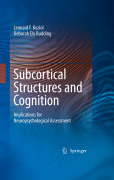
Subcortical structures and cognition: implications for neuropsychological assessment
Koziol, L.F.
Budding, D.E.
Clinical psychologists and neuropsychologists are traditionally taught that cognition is mediated by the cortex and that subcortical brain regions mediate the coordination of movement. However, this argument can easily be challenged based upon the anatomic organization of the brain. The relationship between the prefrontal cortex/frontal lobes and basal ganglia is characterized by loops from these anterior brain regions to the striatum, the globus pallidus, and the thalamus, and then back to the frontal cortex. There is also a cerebrocerebellar system defined by projections from the cerebral cortex to the pontine nuclei, to the cerebellar cortex and deep cerebellar nuclei, to the red nucleus and then back to thalamus and cerebral cortex, including all regions of the frontal lobes. Therefore, both the cortical-striatal and cortical-cerebellar projections are anatomically defined as re-entrant systems that are obviously in aposition to influence not only motor behavior, but also cognition and affect.No other books available that discuss the cognitive and emotional aspects of subcortical pathology at the level of clinical neuropsychology At the cutting edge of clinical research connecting subcortical processes to cognition and affect INDICE: 1: Introduction: Movement, Cognition, and the Vertically OrganizedBrain.- 2: The Basal Ganglia: Beyond the Motor System – From Movement to Thought.- 3: Frontal-Subcortical Real Estate: Location, Location, Location.- 4: Learning and the Basal Ganglia: Benefiting from Action and Reinforcement.- 5: The Cerebellum: Quality Control, Creativity, Intuition, and Unconscious Working Memory.- 6: Automaticity and Higher Order Control in Communication: A Brief Introduction to Language and Social Cognition.- 7.- The Vertically Organized Brain in Clinical Psychiatric Disorder.- 8: Familiarity and Novelty – Evaluating the Frontostriatal System.- 9: Thought in Action: Procedural Learning, Processing Speed, and Automaticity.- 10: The Basal Ganglia and Neuropsychological Testing.- 11: The Cerebellum in Neuropsycholocial Testing.- 12: The Integrated Brain: Implications for Neuropsychological Evaluation.
- ISBN: 978-0-387-84866-2
- Editorial: Springer
- Encuadernacion: Cartoné
- Páginas: 280
- Fecha Publicación: 01/02/2009
- Nº Volúmenes: 1
- Idioma: Inglés
